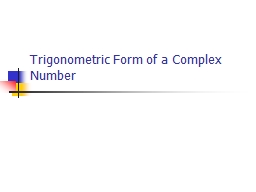

Complex Numbers Recall that a complex number has a real component and an imaginary component z a bi Argand Diagram Real axis Imaginary axis z 3 2i z 3 2i a bi The absolute value of a complex number is its distance from the origin ID: 1030636
Download Presentation The PPT/PDF document "Trigonometric Form of a Complex Number" is the property of its rightful owner. Permission is granted to download and print the materials on this web site for personal, non-commercial use only, and to display it on your personal computer provided you do not modify the materials and that you retain all copyright notices contained in the materials. By downloading content from our website, you accept the terms of this agreement.
1. Trigonometric Form of a Complex Number
2. Complex NumbersRecall that a complex number has a real component and an imaginary component.z = a + biArgand DiagramReal axisImaginary axisz = 3 – 2iz = 3 – 2iabiThe absolute value of a complex number is its distance from the origin.The names and letters are changing, but this sure looks familiar.
3. The Trig form of a Complex Number
4. How is it Different?In a rectangular system, you go left or right and up or down.In a trigonometric or polar system, you have a direction to travel and a distance to travel in that direction.
5. Converting from Rectangular form to Trig formConvert z = 4 + 3i to trig form.1. Find r2. Find 3. Fill in the blanks
6. Converting from Trig Form to Rectangular FormThis one’s easy.Evaluate the sin and cos.Distribute in rConvert 4(cos 30 + i sin 30) to rectangular form.1. Evaluate the sin and cos2. Distribute the 4.
7. Multiplying Complex NumbersTo multiply complex numbers in rectangular form, you would FOIL and convert i2 into –1.To multiply complex numbers in trig form, you simply multiply the rs and add the thetas.The formulas are scarier than they really are.Whoa … what just happened here?
8. ExampleRectangular formTrig form
9. Dividing Complex NumbersIn rectangular form, you rationalize using the complex conjugate.In trig form, you just divide the rs and subtract the theta.
10. ExampleRectangular formTrig form
11. De Moivre’s TheoremIf is a complex numberAnd n is a positive integerThen
12. Who was De Moivre?A brilliant French mathematician who was persecuted in France because of his religious beliefs. De Moivre moved to England where he tutored mathematics privately and became friends with Sir Issac Newton.De Moivre made a breakthrough in the field of probability (writing the Doctrine of Chance), but more importantly he moved trigonometry into the field of analysis through complex numbers with De Moivre’s theorem.
13. But, can we prove DeMoivre’s Theorem?Let’s look at some Powers of z.
14. Let’s look at some more Powers of z.
15. It appears that:Assume n=1, then the statement is true. We can continue in the previous manor up to some arbitrary kLet n = k, so that:Now find Proof:
16. Euler’s FormulaWe can also use Euler’s formula to prove DeMoivre’s Theorem.
17. So what is the use?Find an identity for using Mr. De Moivre’s fantastic theory Remember the binomial expansion: Apply it:Cancel out the imaginery numbers:
18. Now try these:
19. Powers of Complex NumbersThis is horrible in rectangular form.The best way to expand one of these is using Pascal’s triangle and binomial expansion. You’d need to use an i-chart to simplify.It’s much nicer in trig form. You just raise the r to the power and multiply theta by the exponent.
20. Roots of Complex NumbersThere will be as many answers as the index of the root you are looking forSquare root = 2 answersCube root = 3 answers, etc.Answers will be spaced symmetrically around the circleYou divide a full circle by the number of answers to find out how far apart they are
21. The formulak starts at 0 and goes up to n-1This is easier than it looks.Using DeMoivre’s Theorem we get
22. General ProcessProblem must be in trig formTake the nth root of r. All answers have the same value for r.Divide theta by n to find the first angle.Divide a full circle by n to find out how much you add to theta to get to each subsequent answer.
23. Example1. Find the 4th root of 812. Divide theta by 4 to get the first angle.3. Divide a full circle (360) by 4 to find out how far apart the answers are.List the 4 answers. The only thing that changes is the angle.The number of answers equals the number of roots.